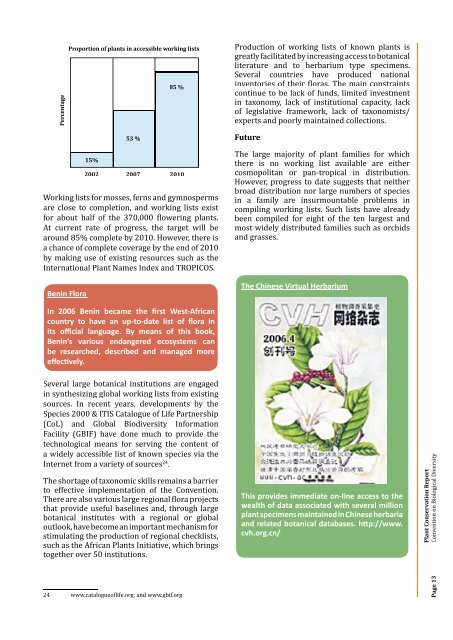from the global partnership for plant conservation
from the global partnership for plant conservation
from the global partnership for plant conservation
Create successful ePaper yourself
Turn your PDF publications into a flip-book with our unique Google optimized e-Paper software.
PercentageWorking lists <strong>for</strong> mosses, ferns and gymnospermsare close to completion, and working lists exist<strong>for</strong> about half of <strong>the</strong> 370,000 lowering <strong>plant</strong>s.At current rate of progress, <strong>the</strong> target will bearound 85% complete by 2010. However, <strong>the</strong>re isa chance of complete coverage by <strong>the</strong> end of 2010by making use of existing resources such as <strong>the</strong>International Plant Names Index and TROPICOS.Benin FloraProportion of <strong>plant</strong>s in accessible working lists15%200253 %200785 %2010Production of working lists of known <strong>plant</strong>s isgreatly facilitated by increasing access to botanicalliterature and to herbarium type specimens.Several countries have produced nationalinventories of <strong>the</strong>ir loras. The main constraintscontinue to be lack of funds, limited investmentin taxonomy, lack of institutional capacity, lackof legislative framework, lack of taxonomists/experts and poorly maintained collections.FutureThe large majority of <strong>plant</strong> families <strong>for</strong> which<strong>the</strong>re is no working list available are ei<strong>the</strong>rcosmopolitan or pan-tropical in distribution.However, progress to date suggests that nei<strong>the</strong>rbroad distribution nor large numbers of speciesin a family are insurmountable problems incompiling working lists. Such lists have alreadybeen compiled <strong>for</strong> eight of <strong>the</strong> ten largest andmost widely distributed families such as orchidsand grasses.The Chinese Virtual HerbariumIn 2006 Benin became <strong>the</strong> first West-Africancountry to have an up-to-date list of flora inits official language. By means of this book,Benin’s various endangered ecosystems canbe researched, described and managed moreeffectively.Several large botanical institutions are engagedin syn<strong>the</strong>sizing <strong>global</strong> working lists <strong>from</strong> existingsources. In recent years, developments by <strong>the</strong>Species 2000 & ITIS Catalogue of Life Partnership(CoL) and Global Biodiversity In<strong>for</strong>mationFacility (GBIF) have done much to provide <strong>the</strong>technological means <strong>for</strong> serving <strong>the</strong> content ofa widely accessible list of known species via <strong>the</strong>Internet <strong>from</strong> a variety of sources 24 .The shortage of taxonomic skills remains a barrierto effective implementation of <strong>the</strong> Convention.There are also various large regional lora projectsthat provide useful baselines and, through largebotanical institutes with a regional or <strong>global</strong>outlook, have become an important mechanism <strong>for</strong>stimulating <strong>the</strong> production of regional checklists,such as <strong>the</strong> African Plants Initiative, which bringstoge<strong>the</strong>r over 50 institutions.24 www.catalogueolife.org; and www.gbif.orgThis provides immediate on-line access to <strong>the</strong>wealth of data associated with several million<strong>plant</strong> specimens maintained in Chinese herbariaand related botanical databases. http://www.cvh.org.cn/Plant Conservation ReportPage 13 Convention on Biological Diversity
















